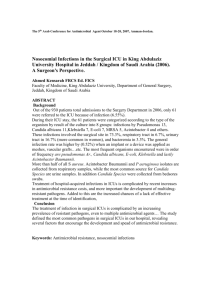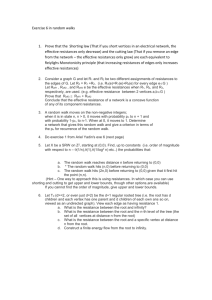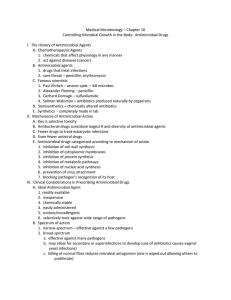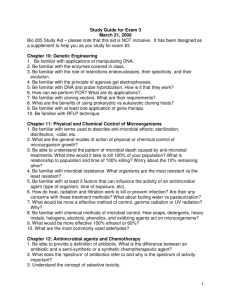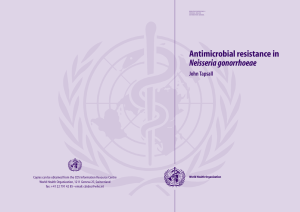Drug Resistant Gonorrhoea-A Public Health Challenge
advertisement
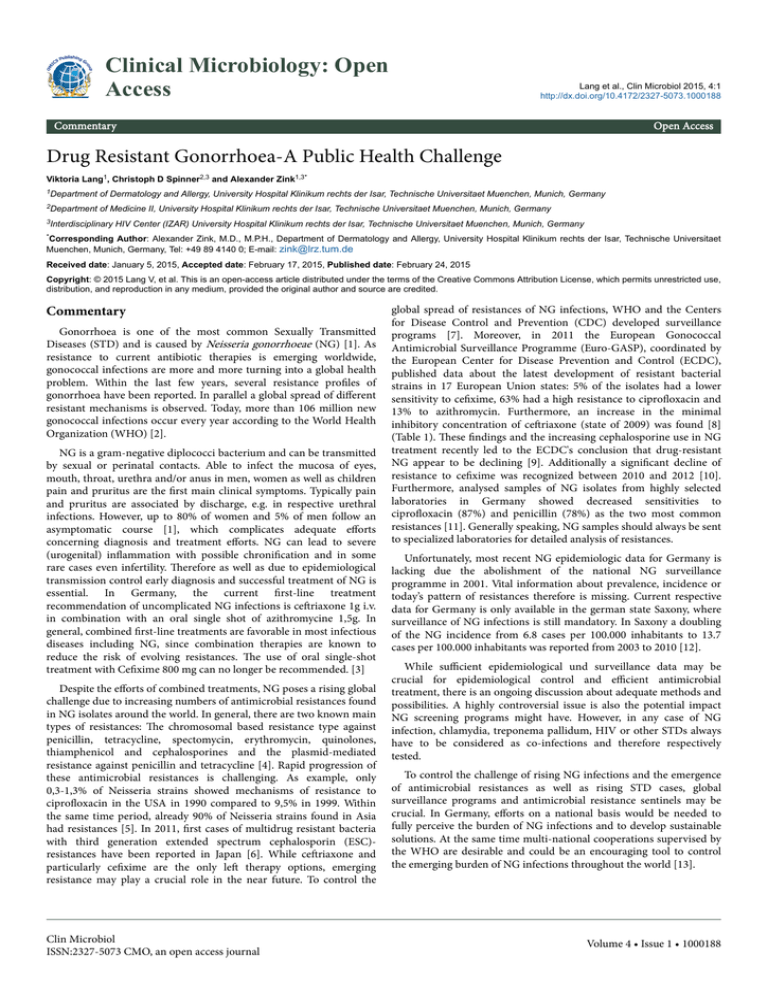
Clinical Microbiology: Open Access Lang et al., Clin Microbiol 2015, 4:1 http://dx.doi.org/10.4172/2327-5073.1000188 Commentary Open Access Drug Resistant Gonorrhoea-A Public Health Challenge Viktoria Lang1, Christoph D Spinner2,3 and Alexander Zink1,3* 1Department of Dermatology and Allergy, University Hospital Klinikum rechts der Isar, Technische Universitaet Muenchen, Munich, Germany 2Department of Medicine II, University Hospital Klinikum rechts der Isar, Technische Universitaet Muenchen, Munich, Germany 3Interdisciplinary HIV Center (IZAR) University Hospital Klinikum rechts der Isar, Technische Universitaet Muenchen, Munich, Germany *Corresponding Author: Alexander Zink, M.D., M.P.H., Department of Dermatology and Allergy, University Hospital Klinikum rechts der Isar, Technische Universitaet Muenchen, Munich, Germany, Tel: +49 89 4140 0; E-mail: zink@lrz.tum.de Received date: January 5, 2015, Accepted date: February 17, 2015, Published date: February 24, 2015 Copyright: © 2015 Lang V, et al. This is an open-access article distributed under the terms of the Creative Commons Attribution License, which permits unrestricted use, distribution, and reproduction in any medium, provided the original author and source are credited. Commentary Gonorrhoea is one of the most common Sexually Transmitted Diseases (STD) and is caused by Neisseria gonorrhoeae (NG) [1]. As resistance to current antibiotic therapies is emerging worldwide, gonococcal infections are more and more turning into a global health problem. Within the last few years, several resistance profiles of gonorrhoea have been reported. In parallel a global spread of different resistant mechanisms is observed. Today, more than 106 million new gonococcal infections occur every year according to the World Health Organization (WHO) [2]. NG is a gram-negative diplococci bacterium and can be transmitted by sexual or perinatal contacts. Able to infect the mucosa of eyes, mouth, throat, urethra and/or anus in men, women as well as children pain and pruritus are the first main clinical symptoms. Typically pain and pruritus are associated by discharge, e.g. in respective urethral infections. However, up to 80% of women and 5% of men follow an asymptomatic course [1], which complicates adequate efforts concerning diagnosis and treatment efforts. NG can lead to severe (urogenital) inflammation with possible chronification and in some rare cases even infertility. Therefore as well as due to epidemiological transmission control early diagnosis and successful treatment of NG is essential. In Germany, the current first-line treatment recommendation of uncomplicated NG infections is ceftriaxone 1g i.v. in combination with an oral single shot of azithromycine 1,5g. In general, combined first-line treatments are favorable in most infectious diseases including NG, since combination therapies are known to reduce the risk of evolving resistances. The use of oral single-shot treatment with Cefixime 800 mg can no longer be recommended. [3] Despite the efforts of combined treatments, NG poses a rising global challenge due to increasing numbers of antimicrobial resistances found in NG isolates around the world. In general, there are two known main types of resistances: The chromosomal based resistance type against penicillin, tetracycline, spectomycin, erythromycin, quinolones, thiamphenicol and cephalosporines and the plasmid-mediated resistance against penicillin and tetracycline [4]. Rapid progression of these antimicrobial resistances is challenging. As example, only 0,3-1,3% of Neisseria strains showed mechanisms of resistance to ciprofloxacin in the USA in 1990 compared to 9,5% in 1999. Within the same time period, already 90% of Neisseria strains found in Asia had resistances [5]. In 2011, first cases of multidrug resistant bacteria with third generation extended spectrum cephalosporin (ESC)resistances have been reported in Japan [6]. While ceftriaxone and particularly cefixime are the only left therapy options, emerging resistance may play a crucial role in the near future. To control the Clin Microbiol ISSN:2327-5073 CMO, an open access journal global spread of resistances of NG infections, WHO and the Centers for Disease Control and Prevention (CDC) developed surveillance programs [7]. Moreover, in 2011 the European Gonococcal Antimicrobial Surveillance Programme (Euro-GASP), coordinated by the European Center for Disease Prevention and Control (ECDC), published data about the latest development of resistant bacterial strains in 17 European Union states: 5% of the isolates had a lower sensitivity to cefixime, 63% had a high resistance to ciprofloxacin and 13% to azithromycin. Furthermore, an increase in the minimal inhibitory concentration of ceftriaxone (state of 2009) was found [8] (Table 1). These findings and the increasing cephalosporine use in NG treatment recently led to the ECDC's conclusion that drug-resistant NG appear to be declining [9]. Additionally a significant decline of resistance to cefixime was recognized between 2010 and 2012 [10]. Furthermore, analysed samples of NG isolates from highly selected laboratories in Germany showed decreased sensitivities to ciprofloxacin (87%) and penicillin (78%) as the two most common resistances [11]. Generally speaking, NG samples should always be sent to specialized laboratories for detailed analysis of resistances. Unfortunately, most recent NG epidemiologic data for Germany is lacking due the abolishment of the national NG surveillance programme in 2001. Vital information about prevalence, incidence or today’s pattern of resistances therefore is missing. Current respective data for Germany is only available in the german state Saxony, where surveillance of NG infections is still mandatory. In Saxony a doubling of the NG incidence from 6.8 cases per 100.000 inhabitants to 13.7 cases per 100.000 inhabitants was reported from 2003 to 2010 [12]. While sufficient epidemiological und surveillance data may be crucial for epidemiological control and efficient antimicrobial treatment, there is an ongoing discussion about adequate methods and possibilities. A highly controversial issue is also the potential impact NG screening programs might have. However, in any case of NG infection, chlamydia, treponema pallidum, HIV or other STDs always have to be considered as co-infections and therefore respectively tested. To control the challenge of rising NG infections and the emergence of antimicrobial resistances as well as rising STD cases, global surveillance programs and antimicrobial resistance sentinels may be crucial. In Germany, efforts on a national basis would be needed to fully perceive the burden of NG infections and to develop sustainable solutions. At the same time multi-national cooperations supervised by the WHO are desirable and could be an encouraging tool to control the emerging burden of NG infections throughout the world [13]. Volume 4 • Issue 1 • 1000188 Citation: Lang V, Spinner CD, Zink A (2015) Drug Resistant Gonorrhoea-A Public Health Challenge. Clin Microbiol 4: 188. doi: 10.4172/2327-5073.1000188 Page 2 of 2 Country Number tested of isolates Azithromycin Ciprofloxacin PPNG n (%) n (%) n (%) Fully susceptible France 104 19 (18) 45 (43) 6 (6) 53 (51) Germany 45 0 33 (73) 3 (7) 12 (27) Italy 70 20 (29) 53 (76) 5 (7) 16 (23) Sweden 108 11 (10) 77 (71) 37 (34) 25 (23) UK 120 5 (4) 42 (35) 7 (6) 76 (63) Table 1: Neisseria gonorrhoea resistance to azithromycin, ciprofloxacin, high-level resistance to penicillin and strains fully susceptible to all antimicrobial drugs in selected countries 2009 (n= 1,366) Acknowledgement This work was supported by the German Research Foundation (DFG) and the Technische Universität München within the funding programme Open Access Publishing References 1. World Health Organization (2008) Global incidence and prevalence of selected curable sexually transmitted infections. 2. World Health Organization (2013) Sexually transmitted infections (STIs), The importance of a renewed commitment to STI prevention and control in achieving global sexual and reproductive health. Department of Reproductive Health and Research. 3. AWMF (2013) Gonorrhoe bei Erwachsenen und Adoleszenten. 4. World Health Organization (2003) Guidelines for the management of sexually transmitted infections. 5. Shigemura K, Fujisawa M (2014) History and Epidemiology of Antibiotic Susceptibilities of Neisseria Gonorrhoeae. Curr Drug Targets 19. 6. Ohnishi M, Golparian D, Shimuta K, Saika T, Hoshina S, et al. (2011) Is Neisseria gonorrhoeae initiating a future era of untreatable gonorrhea?: Clin Microbiol ISSN:2327-5073 CMO, an open access journal 7. 8. 9. 10. 11. 12. 13. detailed characterization of the first strain with high-level resistance to ceftriaxone. Antimicrob Agents Chemother 55: 3538-3545. World Health Organization (2012) Global action plan to control the spread and impact of antimicrobial resistance in Neisseria gonorrhoeae Cole MJ, Unemo M, Hoffmann S, Chisholm SA, Ison CA, et al. (2011) The European gonococcal antimicrobial surveillance programme. Eurosurveillance 16: 19995. European Centre for Disease Prevention and Control (2014) Surveillance Report Gonococcal antimicrobial susceptibility surveillance in Europe, 2012. Stockholm. European Centre for Disease Prevention and Control (2014) Surveillance Report Gonococcal antimicrobial susceptibility surveillance in Europe, 2012. p10 Stockholm. Erste Ergebnisse des Gonokokken-Resistenz-Netzwerks (2014) Diagnostik und Antibiotikaresistenztestung von Neisseria gonorrhoeae in Deutschland. Epidemiologisches Bulletin 37: 365-372. Robert-Koch-Institut (2011) Gonorrhö: Erster Cefixim-resistenter Stamm führt in Öster-reich zu Therapieversagen; Situation in Deutschland. Epidemiologisches Bulletin 47: 429-434. Volume 4 • Issue 1 • 1000188


